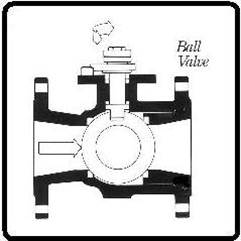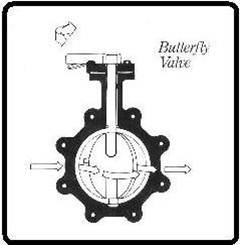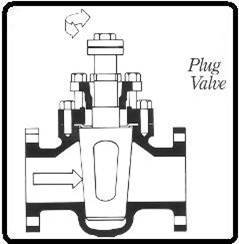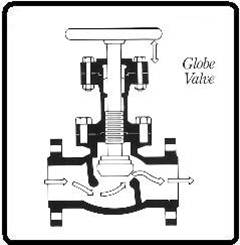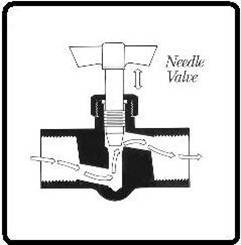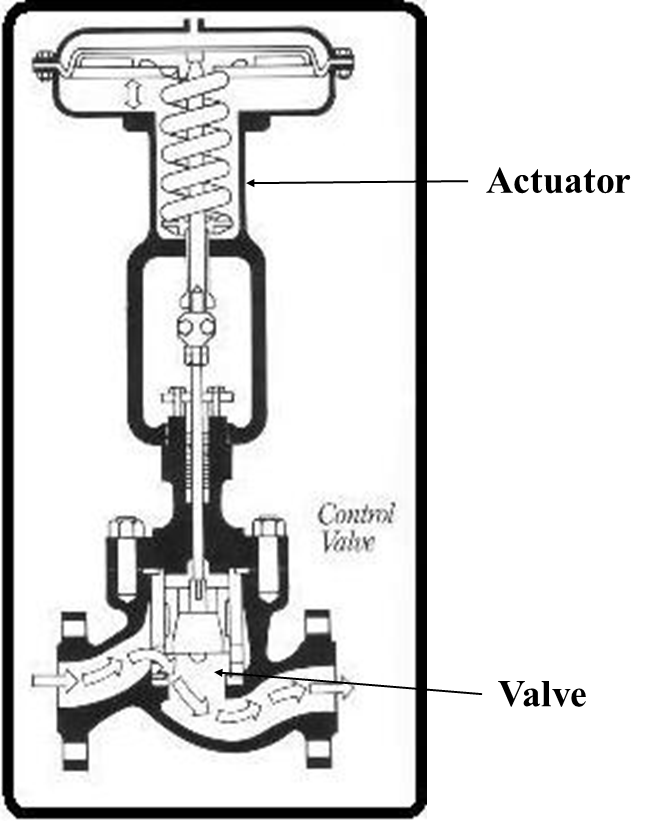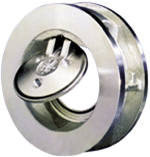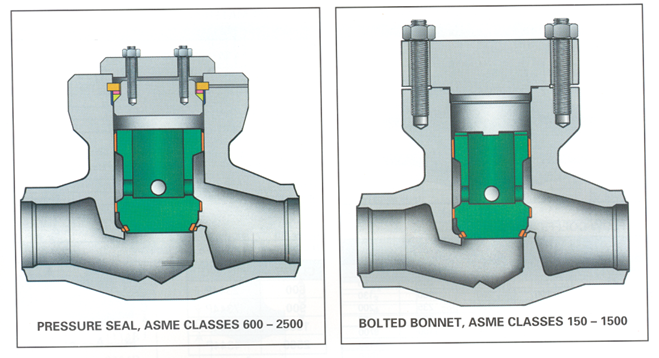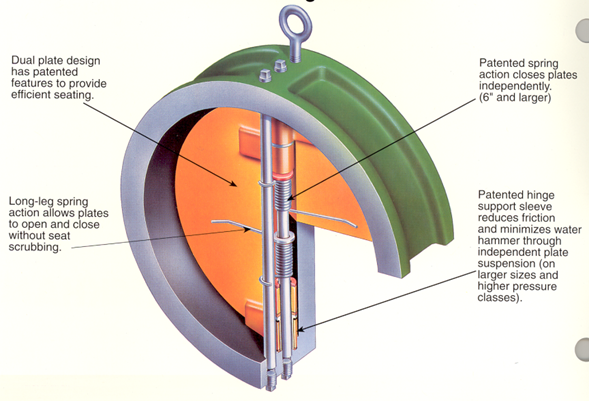Process hydraulics: Difference between revisions
Sean Kelton (talk | contribs) (→Valves) |
TJConsidine (talk | contribs) No edit summary |
||
| Line 43: | Line 43: | ||
<math>W = \int\limits_{P_1}^{P_2} V\, dP</math> |
<math>W = \int\limits_{P_1}^{P_2} V\, dP</math> |
||
where V is the volumetric flow rate. Generally, the volumetric flow rate of a liquid is approximately two orders of magnitude less than the volumetric flow rate of a gas, which means a 10hp pump is comparable in fluid pressurizing capacity to a 1000hp compressor. (Seider 132). |
|||
===Pumps== |
|||
As stated above, pumps require relatively little power compared to gas compressors. However, they are easily vapor locked when pumping liquids near the bubble point because small amounts of vapor can become trapped within their rotating blades. Pumps increase the pressure energy of the effluent fluid by the transfer of kinetic energy from the motor to the fluid, through the impeller. (Seider 642). Selection of pumps for specific services requires knowledge of the liquid to be handled, the total dynamic head required, the suction and discharge heads, and in most cases, the temperature, viscosity, vapor pressure, and density of the fluid. The different types of pumps used in industry can be classified as centrifugal pumps, positive displacement pumps, jet pumps, and electromagnetic pumps. (Peters 508). |
|||
==Valves== |
==Valves== |
||
Revision as of 23:03, 9 February 2014
Authors: Thomas Considine, Sean Kelton, Michael Gleeson
Introduction
The transportation and storage of fluids is essential to a chemical process plant. Piping, valves, pumps and compressors comprise the major components of fluid handling equipment. The goal of process hydraulics in a design setting is to overcome frictional losses in piping and equipment, provide correct operating conditions, and overall assist in the controls of the plant. All three objectives must be design in concert, and before the final controls system is designed. (Towler, 1207).
Hydraulic systems & Pressure drop
Overall pressure drops created by pumps and compressors must also include those created by the connecting pipes. These components must be designed in concert, to account for changes in elevation and friction losses in the pipe.
Total Pressure Drop
Pressure drops throughout the flow of a fluid can be summed to find the overall pressure drop of a defined system. For example: If a fluid A, initially at zero gauge pressure, is pumped to a pressure of 300 kPa, then flows through 10 meters of pipe resulting in a loss of 50 kPa, the final gauge pressure at the end of the pipe is 250 kPa. This type of analysis is useful when designing pressure systems over many components.
Pressure Drop in Pipes
When designing pumps and compressors, the loss of pressure due to piping is not negligible, and must be appropriately accounted for (Turton, 537). The pressure change in pressure across a pipe is calculated as follows:
where and are specific coefficient (typically 0.005 for turbulent flows), the length of piping, the diameter of piping, the density of the fluid, and the velocity of the fluid.
An added term accounting for the pressure difference due to height is also necessary if there is a change in elevation.
Additionally, the first term in the equation can be altered to include an additional factor:
which accounts for piping bends, restrictions, and other variables.
Heuristics
Both the process hydraulics and the economics of a system is affected by pipe sizing (Peters, 500). Heuristics, or "Rules-of-thumbs" have been developed to assist in optimizing pipe selection. While more detailed optimization techniques are available and commonly used, the rules of thumb provide a good starting point for pipe selection.
Suggested pipe velocities, in ft/s, for gases, liquids, and super-heated steam are approximately 60-100, 6, and 150, respectively (Towler Presentation, 9). Additionally, for liquid flow, the following equation provides a rule-of-thumb for optimal pipe diameter, in inches:
Where D is the optimal diameter, and Flow is in units of gallons/minute.
Pumps & Compressors
Pumps and Compressors are used to pressurize liquids and gases, respectively, and to transfer them from one location to another. In general, it is preferable to increase the pressure of a stream by pumping a liquid rather than compressing a gas because it is far less expensive. This is because the power needed to increase the pressure of a stream is:
where V is the volumetric flow rate. Generally, the volumetric flow rate of a liquid is approximately two orders of magnitude less than the volumetric flow rate of a gas, which means a 10hp pump is comparable in fluid pressurizing capacity to a 1000hp compressor. (Seider 132).
=Pumps
As stated above, pumps require relatively little power compared to gas compressors. However, they are easily vapor locked when pumping liquids near the bubble point because small amounts of vapor can become trapped within their rotating blades. Pumps increase the pressure energy of the effluent fluid by the transfer of kinetic energy from the motor to the fluid, through the impeller. (Seider 642). Selection of pumps for specific services requires knowledge of the liquid to be handled, the total dynamic head required, the suction and discharge heads, and in most cases, the temperature, viscosity, vapor pressure, and density of the fluid. The different types of pumps used in industry can be classified as centrifugal pumps, positive displacement pumps, jet pumps, and electromagnetic pumps. (Peters 508).
Valves
A valve is a mechanical tool used to control the flow of material in a system by blocking or restricting the materials flow path; typically used on piping. Valves serve many purposes including but not limited to: beginning or quenching the flow of a material through a system, regulating the flow rate of the material traveling through a system, regulating the pressure of a material flowing through a system, prevent back-flow of a material and changing the flow direction at intersection points. Any valve in a piping system will cause a pressure drop. As a rule of thumb, 10 psi change in pressure should be accounted for across each valve when designing a plant.
More specifically, the table below gives the pressure drop of different types of valves in the number of velocity heads lost.
| Valve or Fitting Type | No. Velocity Heads, n | Valve or Fitting Type | No. Velocity Heads, n |
|---|---|---|---|
| 45 degree ell, standard | 0.35 | Globe valve, bevel seat, open | 6 |
| 90 degree ell, standard | 0.75 | Globe valve, bevel seat, ½ open | 9.5 |
| 180 degree bend, close return | 1.5 | Globe valve, plug disk, open | 9 |
| Tee, along run, branch blanked off | 0.4 | Globe valve, plug disk, ¾ open | 13 |
| Tee, entering run or entering branch | 1 | Globe valve, plug disk, ½ open | 36 |
| Tee, branching flow | 1 | Globe valve, plug disk, ¼ open | 112 |
| Gate valve, open | 0.17 | Plug valve, 5 degrees open | 0.05 |
| Gate valve, ¾ open | 0.9 | Plug valve, 20 degrees open | 1.56 |
| Gate valve, ½ open | 4.5 | Plug valve, 40 degrees open | 17.3 |
| Gate valve, ¼ open | 24 | Plug valve, 60 degrees open | 206 |
| Check valve, swing | 2 | Pipe union | 0.04 |
Gate Valve
A gate valve is comprised of a wedge that slides up and down perpendicular to the path of fluid flow on screw type mechanism, which spins in opposite directions to open/close the valve, in order to allow and block fluid flow respectively. This type of valve is an ON/OFF valve and therefore should either be operated fully open or fully closed. Operating partially open can degrade the seal on the valve. The fluid path is straight through the valve and therefore minimal pressure drop results.
Ball Valve
A ball valve is another type of ON/OFF valve that only operates fully opened or closed with the flow path straight through the valve. However, these valves only require a quarter turn to open or close the valve and therefore can quench flow much faster than a gate valve. Rather than blocking flow with a wedge, a ball valve turns so that the opening aligns with the pipe to allow flow or pipe wall to block flow.
Butterfly Valve
A butterfly valve also requires only a quarter turn to switch between the open and closed position. A flat plate switches positions between being parallel or perpendicular to flow in order to allow or prevent flow through the valve respectively. This valve does not seal well on its own and, unaided, can be pushed open by fluid flow, therefore extra materials are required for complete shutdown of flow.
Plug Valve
A plug valve is very similar to a ball valve, except it is used in situations in which a better seal is needed. The valve uses plug stationed in lubricated lining to provide the seal and once again a quarter turn will open/close the valve by aligning the hole within the plug to the pipe/wall respectively. There is an upper limit to the temperature a which a plug valve can be used, ~450 F, because after this point heat expansion differences of the liner and plug ruins the seal.
Globe Valve
A globe valve is a type of throttling valve, controlling the fluid flow rate, in which the height of a disk is adjusted between two vertical plates. The gap between the disk and the second vertical plate, known as the seat, can be adjusted to regulate flow rate, however, the valve should not be run at very slow flow rates (<10% open) because the flowing fluid will cause damage to the seat. The two vertical directional changes of the fluid flow path cause greater pressure drops across these valves. This type of valve can be adjusted automatically (using a machine program) or manually by a worker.
Needle Valve
A needle valve is much like a globe valve, however, a stem with a conical head is used to control the flow rate. The conical head provides a more accurate and precise flow rate control. Additionally, the conical head does not have problems at low flow rates as the flat disk of a globe valve exhibits.
Control Valve
Control valves are a classification of automatic globe valves. These valves use an electric actuator or some type of compressed air system to adjust the flow rate through the valve via signaling from an electric control program.
Check Valve
Check valves are valves that are used to control the flow direction within the pipe (i.e. prevent back-flow). The three main types are swing valves, lift valves and wafer valves (respectively below). Swing valves push a swinging mechanism forward to allow forward flow, but is blocked in the other direction because the weight of the disc holds itself in place. These valves are most common in industry. These valves are not good when flow rate pulsates or is very high, nor if the fluid is a slurry or a gas. Lift valves use vertical plates, as in a throttling valve, to divert flow in an upward direction to lift a move-able piece that is otherwise held in place by gravity preventing reverse flow. Wafer valves use a circular wafer that can only twist in one direction so that forward flow in the pipe spins the wafer to align with the fluid flow and move forward, however, in the reverse direction the hinge is blocked so the wafer can not spin allow flow. These valves require a smaller pressure drop to open and are generally cheaper however they must be used in a very strict flow rate range (~3-11 ft/s).








